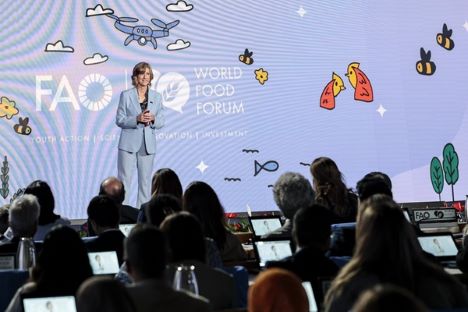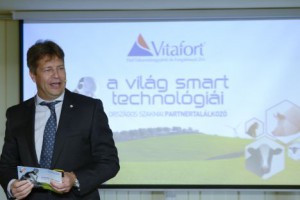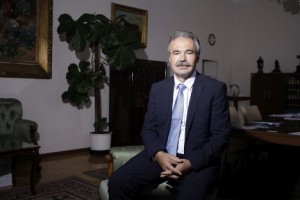Science and Innovation Forum 2024: Digital Agriculture Changemakers in Action
 In remote rural areas, farmers are increasingly embracing digital innovation over traditional manual labor to overcome growing challenges like climate change, resource scarcity, and economic pressures. Smallholder farmers are becoming digital agriculture changemakers, adopting artificial intelligence (AI), blockchain, and precision farming to transform how food is grown, harvested, processed, and distributed. This transformation isn’t a distant promise; it’s already happening.
In remote rural areas, farmers are increasingly embracing digital innovation over traditional manual labor to overcome growing challenges like climate change, resource scarcity, and economic pressures. Smallholder farmers are becoming digital agriculture changemakers, adopting artificial intelligence (AI), blockchain, and precision farming to transform how food is grown, harvested, processed, and distributed. This transformation isn’t a distant promise; it’s already happening.
Farmers, agripreneurs, and innovators are adapting to erratic weather patterns, improving crop yields, and building resilient agrifood systems. Yet, these benefits are not equally accessible. Many vulnerable regions lack the infrastructure, resources, digital literacy, and innovation capacity needed to adopt these technologies effectively. For smallholder farmers, who produce much of the world’s food, digital agriculture must not only boost productivity but also ensure inclusivity.
On October 17, 2024, the FAO Science and Innovation Forum explored these themes in a session called “Digital Agriculture Changemakers in Action.” The event brought together experts, policymakers, and pioneering farmers to showcase real-world applications of digital tools in agriculture. This session spotlighted changemakers using digital solutions to enhance food security and resilience, showing the power of these technologies in meeting global challenges. A central theme of the session was the role of Digital Public Goods (DPGs) and Digital Public Infrastructure (DPI) in promoting resilience and inclusivity in rural farming. DPGs, such as open-access data, software, and foundational services, provide essential resources for a more equitable digital agriculture landscape. The session highlighted how accessible DPGs and DPI can bridge the digital divide, ensuring that farmers in all regions can benefit from digital tools.
Jameson Voisin, Director of Communications and Programs at the Digital Public Goods Alliance (DPGA) discussed the transformative role of DPGs in agrifood systems. He emphasized that DPGs, which include open-source software, datasets, and AI, must meet DPG Standards to ensure they are accessible, adaptable, and usable by countries. “DPGs can be a game-changer in agrifood systems transformation,” Voisin said, thanking FAO for its partnership in making DPGs inclusive and accessible to support sustainable development goals.
Rikin Gandhi, CEO of Digital Green, showcased a video-based knowledge-sharing platform that enables farmers in India, Kenya, and Ethiopia to exchange best practices in pest management, sustainable irrigation, and climate resilience. This platform has already helped improve crop productivity and farmer incomes. Over the past three years, Digital Green has integrated these videos with other resources, including FAO and CGIAR publications, as well as real-time weather and market data. Through an AI solution called Farmer.chat, farmers can now access information in local languages via voice, text, and images, reducing extension costs and amplifying their voices.
In Rwanda, Christella Uwase, CEO of Bountiful Farmers, explained how digital solutions are revolutionizing Irish potato farming. Inspired by her family’s farming legacy, she uses sandponics with IoT technology for potato seed multiplication, enabling real-time environmental monitoring. “Sand lacks natural minerals, so we’ve implemented an automation system to control moisture and manage water and nutrients efficiently,” Uwase explained, emphasizing the environmental benefits of this approach over traditional methods that contribute to erosion and pollution. Jonathan Pound, from FAO’s Global Information and Early Warning System (GIEWS), presented a real-time food security data solution. Using AI and machine learning, GIEWS can predict crop failures or pest outbreaks, enabling farmers to take preventive measures. This data-driven approach is vital for rural farmers, who often lack the resources to recover from environmental or economic shocks. The session stressed the importance of sustainable business models and public-private partnerships (PPPs) to make digital agriculture viable. Building digital infrastructure in rural areas requires coordinated efforts across sectors and regions. PPPs are crucial to ensure digital tools reach even the most marginalized farmers. By working together, governments, tech companies, NGOs, and local communities can create business models that support digital agriculture, even in remote areas.
Professor Loubna El Mansouri, Director of Morocco’s Digital Pole for Agriculture, Forestry, and Drought Observatory, shared Morocco’s approach to advancing digital transformation in agriculture. Established in partnership with the private sector, academia, and farmer organizations, the Digital Pole coordinates digital agriculture efforts with strong institutional and financial support, promoting a sustainable agrifood ecosystem. As climate change intensifies, rural farmers face increasingly unpredictable weather and limited resources. Digital tools offer valuable ways to adapt to these changes, provided they are accessible to all. The FAO session emphasized the need for open-access data services and collaboration to support smallholder farmers—the group most vulnerable to climate impacts—ensuring they aren’t left behind in the digital revolution.
Sriram Bharatam, Founder of KUZA Biashara Limited, described Kuza Farm’s approach in Kenya, which combines a rural entrepreneurship incubator with a digital value chain platform accessible offline. “By creating a digital agriculture open network that works without internet access, we provide reliable, inclusive support for rural farmers,” Bharatam explained, highlighting the impact of bridging access gaps and empowering local entrepreneurs. Pinduoduo, a Chinese agriculture-focused e-commerce platform, was another example discussed in the session. This platform leverages big data to increase transparency and trust in the agrifood system, improving logistics by connecting farmers to consumers and reducing food waste. “We started as agricultural product retailers and became China’s largest marketplace for agriculture,” said Haiwei Wang, vice president of Pinduoduo.
Dejan Jakovljevic, FAO Chief Information Officer, closed the session by thanking all participants and contributors. He expressed appreciation to Nosipho Nausca-Jean Jezile for facilitating and summarizing key insights for scaling digital innovation in agrifood systems. Reflecting on the FAO Science and Innovation Forum 2024, Jakovljevic praised the impactful examples of digital solutions that can bridge global food security gaps. “The solutions discussed today, along with the concept of Digital Public Goods, hold immense potential to democratize digital technologies for the benefit of all,” Jakovljevic remarked. He highlighted the importance of inclusivity, connectivity, and support for women and youth as essential drivers in advancing sustainable digital agriculture.
The session underscored that the future of agriculture is digital, led by innovators addressing global challenges with advanced technology. Through AI-based weather prediction, blockchain-enabled supply chain transparency, and video-based knowledge-sharing, these changemakers are building a resilient and fair global food system. The FAO Science and Innovation Forum continues to inspire the next generation to leverage these tools for food security and rural resilience. As climate change and food insecurity increase, their work signals a sustainable, inclusive future for farmers worldwide.










